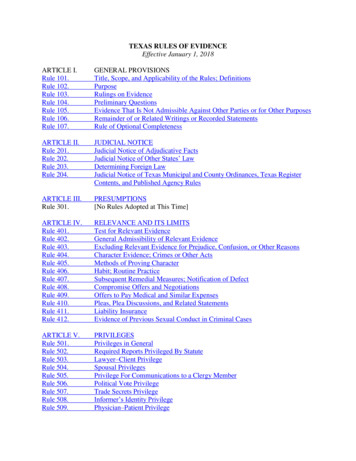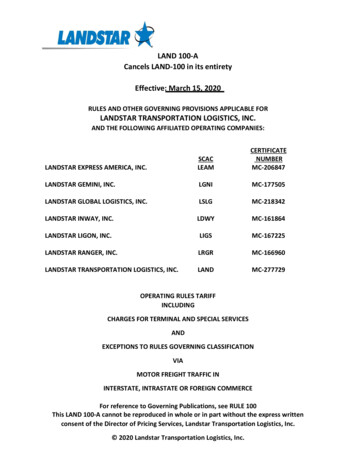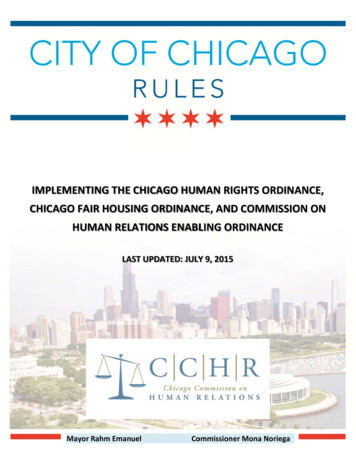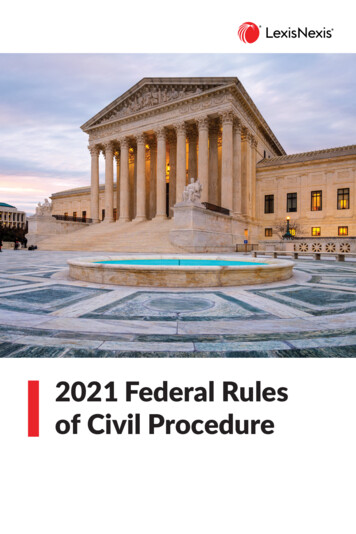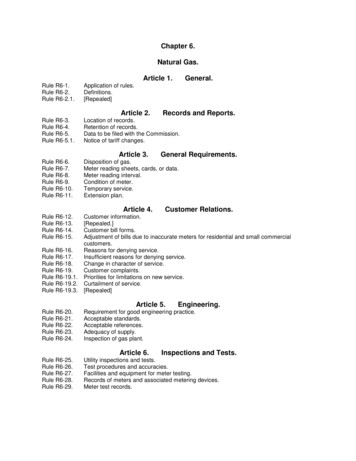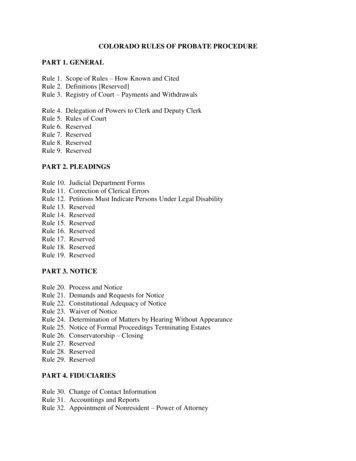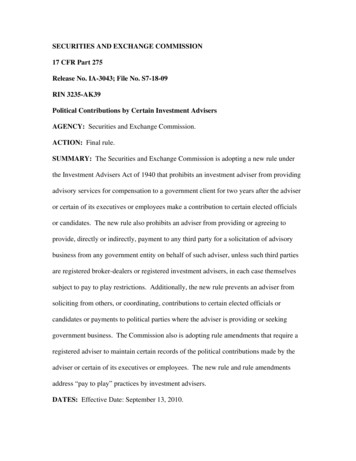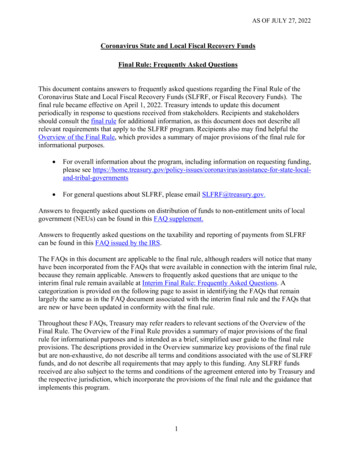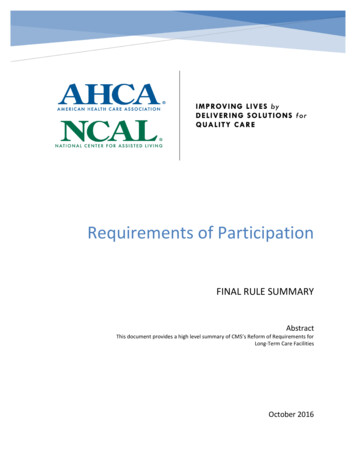
Transcription
Requirements of ParticipationFINAL RULE SUMMARYAbstractThis document provides a high level summary of CMS’s Reform of Requirements forLong-Term Care FacilitiesOctober 2016
Table of ContentsExecutive SummaryOn Wednesday, September 28, 2016, CMS released a final rule entitled Medicare and MedicaidPrograms; Reform of Requirements for Long-Term Care Facilities. The final rule was published inthe federal register on October 4, 2016. It reaffirms some existing requirements, such as existingresident rights, and finalizes a wide range of new requirements, from comprehensive personcentered care planning to compliance and ethics. CMS rejected some of the proposed requirementsin the Notice of Proposed Rulemaking issued on July 16, 2015, such as proposed requirements forphysician credentialing and for requiring an in-person physician visit prior to a resident’sunscheduled transfer from a facility.The regulations are effective on November 28, 2016. However, in response to comments by AHCAand our members, CMS is implementing the regulations using a phased approach. The phases are asfollows:Phase 1: The regulations included in Phase 1 must be implemented by November 28, 2016.Phase 2: The regulations included in Phase 2 must be implemented by November 28, 2017.Phase 3: The regulations included in Phase 3 must be implemented by November 28, 2019.Some regulatory sections are divided among more than one phase, and some of the more extensivenew requirements have been placed in later phases to allow facilities time to successfully prepareto achieve compliance.How to Use This DocumentThere are several elements in this document to help you navigate through key requirements in thefinal rule. Each regulatory section includes: TitleA description of the implementation phase(s)An excerpt from the final rule including CMS’ summary of the key changes to that sectionAdditional Highlights to consider in your review of the new requirementsA page number reference linking to the public review copy of the final rule found onRequirED HERE.The Additional Highlights are not an exhaustive list of all of the requirements in each regulatorysection but are instead meant to draw your attention to some of the important new elements andprovide a starting point for investigating further.Additionally, AHCA hosted a webinar (broadcast twice) with helpful information. Click here to view.1Summary Document: Requirements of Participation
Sections §483.1 Basis and scope§483.5 Definitions§483.10 Resident rights§483.12 Freedom from abuse, neglect, and exploitation§483.15 Admission, transfer, and discharge rights§483.20 Resident assessment§483.21 Comprehensive person-centered care planning§483.24 Quality of life§483.25 Quality of care§483.30 Physician services§483.35 Nursing services§483.40 Behavioral health services§483.45 Pharmacy services§483.50 Laboratory, radiology, and other diagnostic services§483.55 Dental services§483.60 Food and nutrition services§483.65 Specialized rehabilitative services§483.70 Administration§483.75 Quality assurance and performance improvement§483.80 Infection control§483.85 Compliance and ethics program§483.90 Physical environment§483.95 Training requirements
Regulatory SectionImplementation DeadlinePart 483Requirements forStates and LTCFacilitiesClick here to go to thedocumentStarting Page #§483.1 Basis and scope.This entire section will be implemented in Phase 1.CMS Summary: We have added the statutory authority citations for sections 1128I(b) and (c) and section 1150B ofthe Social Security Act (the Act) to include the compliance and ethics program, quality assurance and performanceimprovement (QAPI), and reporting of suspicion of a crime requirements to this section.Additional Highlights:No additional highlights.§483.5 Definitions.This entire section will be implemented in Phase 1.CMS Summary: We have added the definitions for “abuse”, “adverse event”, “exploitation”, “misappropriation ofresident property”, “mistreatment”, “neglect”, “person-centered care”, “resident representative”, and “sexualabuse” to this section.Additional Highlights:Important to review definitions and implications of following terms: “Abuse”: includes verbal abuse, sexual abuse, physical abuse, and mental abuse including abuse facilitatedor enabled through the use of technology. “Person-centered care” (used extensively throughout the rule): focus on the resident as the locus of controland supporting the resident in making their own choices and having control over their daily lives. “Resident representative”: clarifies different types of representatives and limits scope of authority of anyrepresentative to the authority specifically authorized by the resident, State or Federal law, or a court ofcompetent jurisdiction.3Summary Document: Requirements of Participation607608
Regulatory SectionImplementation DeadlinePart 483Requirements forStates and LTCFacilitiesClick here to go to thedocumentStarting Page #§483.10 Resident rights.The section will be implemented in Phase 1 with the followingexception:(g)(4)(ii) – (v) Providing contact information for Stateand local advocacy organizations, Medicare andMedicaid eligibility information, Aging and DisabilityResources Center and Medicaid Fraud Control Unit —Implemented in Phase 2.CMS Summary: We are retaining all existing residents’ rights and updating the language and organization of theresident rights provisions to improve logical order and readability, clarify aspects of the regulation wherenecessary, and updating provisions to include advances such aselectronic communications.Additional Highlights: Includes parallel “facility responsibilities” into resident rights requirements. For example, as a resident hasa right to a dignified existence, self-determination, and communication with and access to persons andservices inside and outside the facility, the facility must treat each resident with respect and dignity andcare for each resident in a manner and in an environment that promotes maintenance or enhancement ofhis or her quality of life, recognizing each resident’s individuality, and protect the rights of the resident,including equal access to quality care. Resident must receive information (oral and written) in language that he or she can understand aboutvarious topics, including their rights, medical condition, Medicare and Medicaid benefits, and informationabout how to contact their physician. The facility must furnish a written description of legal rights, including a list of and contact information forall pertinent State regulatory and informational agencies and advocacy groups. Resident representative:oooResident has the right to designate a representative in accordance with State law, and the residentrepresentative has the right to exercise the resident’s rights to the extent those rights are delegated them. Theresident retains the right to exercise those rights not delegated to a resident representative, including theright to revoke a delegation of rights, except as limited by State law.The same-sex spouse of a resident must be afforded treatment equal to that afforded to an opposite-sexspouse.If the facility has reason to believe the representative is making decisions or taking actions not in theresident’s best interest, the facility shall report such concern in a manner required under State law.611
Regulatory SectionImplementation DeadlinePart 483Requirements forStates and LTCFacilitiesClick here to go to thedocumentStarting Page # Planning and implementing care:ooo Resident has the right to participate in the development and implementation of his or her person-centeredplan of care, including to identify individuals or roles to be included in the planning process; to requestmeetings and the right to request revisions to the plan of care; to identify the expected goals and outcomes ofcare; and to identify the type, amount, frequency, and duration of care, among other factors.Resident has the right to be informed, in advance, of the care to be furnished, the type of care giver orprofessional that will furnish care, and of changes to the plan of care.Resident has the right to see the care plan, including the right to sign after changes to it, and to receive theservices and/or items included in the plan. This does not include the right to receive treatment or medicalservices deemed medically unnecessary or inappropriate.Facility must have a policy and procedure for and inform residents (or their representative, whereappropriate) of the visitation rights of the resident, including any clinical or safety restriction or limitationof such rights when consistent with the regulation.Resident has a right to choose his or her attending physician, and that physician must be licensed topractice.If resident deposits personal funds with the facility, upon written authorization of a resident, the facilitymust act as a fiduciary of the resident’s funds (NOTE: This was moved from guidance into regulation tostrengthen the expectation of facilities).Resident has a right to share a room with his or her roommate of choice when practicable, including sharinga room with his or her spouse when married residents live in the same facility.Resident has the right to reasonable access to and privacy in their use of electronic communications.Facility must have a grievance policy and a Grievance Official responsible for overseeing the grievanceprocess.5Summary Document: Requirements of Participation
Regulatory SectionImplementation Deadline§483.12 Freedom from abuse,neglect, and exploitation.This section will be implemented in Phase 1 with the followingexceptions: (b)(4) Coordination with QAPI Plan—Implemented in Phase 3. (b)(5) Reporting crimes/1150B—Implemented in Phase 2.Part 483Requirements forStates and LTCFacilitiesClick here to go to thedocumentStarting Page #638CMS Summary: We are requiring facilities to investigate and report all allegations of abusive conduct. We also arespecifying that facilities cannot employ individuals who have had a disciplinary action taken against theirprofessional license by a state licensure body as a result of a finding of abuse, neglect, mistreatment of residents ormisappropriation of their property.Additional Highlights: Clarifies that a facility must not employ or otherwise engage individuals who have had a disciplinary actiontaken against a professional license by a state licensure body as a result of a finding of abuse, neglect, ormistreatment of residents or a finding of misappropriation of property. Requires written policies and procedures that: (1) Prohibit and prevent abuse, neglect, and exploitation ofresidents and misappropriation of resident property, (2) Establish policies and procedures to investigateany such allegations, (3) Include training as required in §483.95, (4) Establish coordination with the QAPIprogram required under §483.75, and (5) Ensure reporting of crimes occurring in federally-funded longterm care facilities in accordance with section 1150B of the Act. The policies and procedures must includecertain components specified in the rule.§483.15 Admission, transfer, anddischarge rights.This section will be implemented in Phase 1 with the followingexceptions: (c)(2) Transfer/Discharge Documentation—Implementedin Phase 2.CMS Summary: We are requiring that a transfer or discharge be documented in the medical record and thatspecific information be exchanged with the receiving provider or facility when a resident is transferred.Additional Highlights: Reorganized this section and made modifications to existing language and process related to:o Components and processes around the admission rights including what can and cannot be includedin admission policies including not being able to deny admission or transfer residents out of facilitybecause of their insurance coverage (“equal access to quality of care”).640
Regulatory SectionImplementation DeadlinePart 483Requirements forStates and LTCFacilitiesClick here to go to thedocumentStarting Page #o Transfer & discharge requirements that the resident must remain in the facility unless they meet oneof six criteria for discharge or transfer that is documented by a physician in the record.o The types of information that must be included in a written discharge summary and who it must beshared with.o Process and information needed when transferring or discharging a person with respect to the needto provide a written notice to the resident; timing and contents of the notice; “Orientation” ofresident about their transfer and rights before transfer; and when transfer involves a room change.o Information that must be provided to residents before any discharge or transfer about the facility’s:bed-hold policy, and policy and rights to return to the facility and their prior room as well as theirrights in the appeals process.§483.20 Resident assessment.This entire section will be implemented in Phase 1.CMS Summary: We are clarifying what constitutes appropriate coordination of a resident’s assessment with thePreadmission Screening and Resident Review (PASARR) program under Medicaid. We are also adding referencesto statutory requirements that were inadvertently omitted from the regulation when we first implementedsections 1819 and 1919 of the Act.Additional Highlights: Expanded requirement to include resident strengths, goals, life history and preferences. Changed discharge potential to discharge planning. Assessment process must include direct observation and communication with resident, as well ascommunication with licensed and nonlicensed direct care staff members on all shifts.7Summary Document: Requirements of Participation649
Regulatory SectionImplementation DeadlineComprehensive Person-CenteredCare Planning (§483.21)This section will be implemented in Phase 1 with the following exceptions: Baseline care plan—Implemented in Phase 2. (b)(3)(iii) Trauma informed care—Implemented in Phase 3.Part 483Requirements forStates and LTCFacilitiesClick here to go to thedocumentStarting Page #*New Section*CMS Summary: We are requiring facilities to develop and implement a baseline care plan for each resident, within 48 hours oftheir admission, which includes the instructions needed to provide effective and person-centered care thatmeets professional standards of quality care. We are adding a nurse aide and a member of the food and nutrition services staff to the required members ofthe interdisciplinary team that develops the comprehensive care plan. We are requiring that facilities develop and implement a discharge planning process that focuses on theresident’s discharge goals and prepares residents to be active partners in post-discharge care, in effectivetransitions, and in the reduction of factors leading to preventable re-admissions. We are also implementing thedischarge planning requirements mandated by The Improving Medicare Post-Acute Care Transformation Act of2014 (IMPACT Act) by revising, or adding where appropriate, discharge planning requirements for LTCfacilities.Additional Highlights: Baseline care plan must include 6 specified elements. A summary of the plan, including specifiedinformation, must be provided to the resident and their representative. NOTE: Phase 2 requirement. Comprehensive care plan must be person-centered and consistent with resident’s rights. It must includespecialized services or specialized rehabilitation services as a result of PASARR recommendations; goals foradmission and preference for further discharge; and discharge plans. If resident and representative(s) do not participate in development of plan, an explanation must beincluded in the resident’s medical record. Services must be culturally - competent and trauma-informed. NOTE: trauma-informed is a Phase 3requirement. Discharge summary requires reconciliation of all pre-discharge medications with post-dischargemedications and further expands what must be included in the summary.652
Regulatory SectionImplementation DeadlinePart 483Requirements forStates and LTCFacilitiesClick here to go to thedocumentStarting Page #§483.24 Quality of life.This entire section will be implemented in Phase 1.CMS Summary: We are requiring that each resident receive and the facility provide the necessary care and servicesto attain or maintain the highest practicable physical, mental, and psychosocial well-being, consistent with theresident’s comprehensive assessment and plan of care.Additional Highlights: Quality of Life applies to all care and services throughout the organization. The overarching theme draws from the familiar language of OBRA ’87 – the call to action for every center –Each resident must receive and the facility must provide the necessary care and services to attain or maintainthe highest practicable physical, mental, and psychosocial well-being, consistent with the resident’scomprehensive assessment and plan of care. The continued use of the word “practicable” in this statement isa reminder that, what was true 20 years ago remains true today- our work is to help individuals live at theirhighest optimal level of possibility. The description of activities programs and the staff engaged in them has broadened.§483.25 Quality of care.This section will be implemented in Phase 1 with the followingexception:(m) Trauma-informed care—Implemented in Phase 3.CMS Summary: We are requiring that each resident receive and the facility provide the necessary care and servicesto attain or maintain the highest practicable physical, mental, and psychosocial well-being, consistent with theresident’s comprehensive assessment and plan of care.Additional Highlights: In this section, as with Quality of Life, the definition of Quality of Care has broadened to include all aspectsof treatment and care. It relies on the professional standards of practice in delivering high quality care. Thelanguage infers that staff have competency in the standards of practice.9Summary Document: Requirements of Participation657659
Regulatory SectionImplementation DeadlinePart 483Requirements forStates and LTCFacilitiesClick here to go to thedocumentStarting Page # Areas specifically noted in the Final Rule that are worth reviewing include: vision & hearing, skin integrity,mobility, incontinence, colostomy, urostomy & ileostomy, assisted nutrition & hydration, parenteral fluids,respiratory care, prostheses, pain management, dialysis, trauma informed care and bed rails.There is a new section that focuses on support to trauma survivors. Trauma survivors must receiveculturally competent, trauma-informed care in accordance with professional standards of practice andaccounting for residents’ experiences and preferences in order to mitigate triggers. NOTE: trauma-informedis a Phase 3 requirement.§483.30 Physician services.This entire section will be implemented in Phase 1.CMS Summary: We are allowing attending physicians to delegate dietary orders to qualified dietitians or otherclinically qualified nutrition professionals and therapy orders to therapists.Additional Highlights: The attending physician can delegate the writing of order to Dietician and to therapists per their state‘sscope of practice; NPs and PAs and covering physicians cannot delegate authority; only the attendingphysician. Physician must approve an admission however an NP or PA can now write the admitting orders.664§483.35 Nursing services.666This section will be implemented in Phase 1 with the following exception:Specific usage of the Facility Assessment at §483.70(e)inthe determination of sufficient number and competenciesfor staff —Implemented in Phase 2.CMS Summary: We are adding a competency requirement for determining the sufficiency of nursing staff, based ona facility assessment, which includes but is not limited to the number of residents, resident acuity, range ofdiagnoses, and the content of individual care plans.Additional Highlights: Added assure resident safety. Other nursing personnel includes nurse aides.
Regulatory SectionImplementation Deadline§483.40 Behavioral healthservices.This section will be implemented in Phase 2 with the following exceptions: (a)(1) As related to residents with a history of trauma and/or posttraumatic stress disorder—Implemented inPhase 3. (b)(1), (b)(2), and (d) Comprehensive assessment andmedically related social services--Implemented in Phase 1.Part 483Requirements forStates and LTCFacilitiesClick here to go to thedocumentStarting Page #CMS Summary: We are adding a new section to subpart B that focuses on the requirement to provide the necessary behavioralhealth care and services to residents, in accordance with their comprehensive assessment and plan of care. We are adding “gerontology” to the list of possible human services fields from which a bachelor degree couldprovide the minimum educational requirement for a social worker.Additional Highlights: Based on the comprehensive assessment, a resident with a mental disorder, psychosocial adjustmentdifficulty, or a history of trauma and/or post-traumatic stress disorder must receive appropriate treatmentand services to correct the problem or attain the highest practicable mental and psychosocial well-being. Facility must ensure that if assessment does not reveal mental or psychosocial adjustment difficulties or ahistory of trauma and/or post-traumatic stress disorder, resident does not display a pattern of decreasedsocial interaction and/or increased withdrawn, angry, or depressive behaviors unless clinical conditiondemonstrates development of such a pattern was unavoidable. Facility must have sufficient direct service staff with appropriate competencies and skills to provide thenursing and related services needed to care for residents with mental and psychological disorders, as wellas those with a history of trauma and/or post-traumatic stress disorder. Facility must provide medically-related social services for highest practicable well-being.11Summary Document: Requirements of Participation669
Regulatory SectionImplementation Deadline§483.45 Pharmacy services.This section will be implemented in Phase 1 with the following exceptions: (c)(2) Medical chart review—Implemented in Phase 2. (e) Psychotropic drugs—Implemented in Phase 2.Part 483Requirements forStates and LTCFacilitiesClick here to go to thedocumentStarting Page #672CMS Summary: We are requiring that a pharmacist review a resident’s medical chart during each monthly drug regimenreview. We are revising existing requirements regarding “antipsychotic” drugs to refer to “psychotropic” drugs anddefine “psychotropic drug” as any drug that affects brain activities associated with mental processes andbehavior. We are requiring several provisions intended to reduce or eliminate the need for psychotropic drugs,if not clinically contraindicated, to safeguard the resident’s health.Additional Highlights: Expanded requirement for reporting irregularities to include the facility’s medical director. Expanded requirement for how the pharmacist must document irregularities and how the attendingphysician must respond. Added requirement for facility policy and procedures on monthly drug regimen review. Added limitations to PRN psychotropic drug use.§483.50 Laboratory, radiology,and other diagnostic services.This entire section will be implemented in Phase 1.*New Section*CMS Summary: We are clarifying that a physician assistant, nurse practitioner or clinical nurse specialist mayorder laboratory, radiology, and other diagnostic services for a resident in accordance with state law, includingscope-of-practice laws.Additional Highlights: The facility is responsible for the timeliness and quality of laboratory, radiology, and other diagnosticservices. The facility must assist the resident in making transportation arrangements to and from the source oflaboratory, radiology, and other diagnostic services, if the resident needs assistance.674
Regulatory SectionImplementation DeadlinePart 483Requirements forStates and LTCFacilitiesClick here to go to thedocumentStarting Page # The facility must file in the resident’s clinical record the results of their laboratory, radiology and diagnostictests and communicate the results promptly to the individual that ordered them.If the facility provides its own laboratory services or provides blood bank or transfusion service, they mustmeet the relevant requirements for laboratory services listed in 42 CFR Part 493 – LaboratoryRequirements. Additionally, if the facility is working with a referral laboratory or has an agreement toobtain laboratory services than those laboratories must meet the applicable requirements listed in 42 CFRPart 493 – Laboratory Requirements.If a facility provides its own diagnostic services than those must meet the conditions of participation forhospitals contained in §482.26. If the facility contracts for diagnostic services than the supplier of theseservices has to be approved to provide these services by Medicare.§483.55 Dental services.This section will be implemented in Phase 1 with the following exceptions: (a)(3) and (a)(5) Loss or damage of dentures and policy for referral—Implemented in Phase 2. (b)(3) and (b)(4) Referral for dental services regarding loss ordamaged dentures—Implemented in Phase 2.CMS Summary: We are prohibiting SNFs and NFs from charging a Medicare resident for the loss or damage ofdentures determined in accordance with facility policy to be the facility’s responsibility, and we are adding arequirement that the facility have a policy identifying those instances when the loss or damage of dentures is thefacility’s responsibility. We are requiring NFs to assist residents who are eligible to apply for reimbursement ofdental services under the Medicaid state plan, where applicable.We are clarifying that with regard to a referral for lost or damaged dentures “promptly” means that the referralmust be made within 3 business days unless there is documentation of extenuating circumstances.13Summary Document: Requirements of Participation677
Regulatory SectionImplementation DeadlinePart 483Requirements forStates and LTCFacilitiesClick here to go to thedocumentStarting Page #Additional Highlights: Facility must have a policy in place regarding the loss or damage of dentures, detailing when the loss is atthe facility’s responsibility (see summary statement). Facilities must arrange transportation to and from dental services locations at the request of residents. If the referral doesn’t happen within 3 business days (see summary statement), facilities must documentwhat they did to ensure the resident could eat and drink adequately while awaiting dental services, as wellas the extenuating services leading to the delay.§483.60 Food and nutritionThis section will be implemented in Phase 1 with the following exceptions:services. (a) As linked to Facility Assessment at §483.70(e) Implemented inPhase 2. (a)(1)(iv) Dietitians hired or contracted with prior to effective date—Built in implementation date of 5 years following effective date of thefinal rule. (a)(2)(i) Director of food & nutrition services designated to serve priorto effective—Built in implementation date of 5 years following theeffective date of the final rule. (a)(2)(i) Dietitians designated to after the effective date—Built inimplementation date of 1 year following the effective date of the finalrule.CMS Summary: We are requiring facilities to provide each resident with a nourishing, palatable, well-balanced dietthat meets his or her daily nutritional and special dietary needs, taking into consideration the preferences of eachresident. We are also requiring facilities to employ sufficient staff, including the designation of a director of foodand nutrition service, with the appropriate competencies and skills sets to carry out the functions of dietaryservices while taking into consideration resident assessments and individual plans of care, including diagnosesand acuity, as well as the facility’s resident census.Additional Highlights: Renamed section: Food and Nutritional Services.Focus on resident preference.Staffing: Advances the skills and competencies of those serving in this department and discusses “feeding assistants.”Addresses the procurement of food including locally grown and facility gardens.Addresses meals and snacks offered outside scheduled or at non-traditional times.678
Regulatory SectionImplementation DeadlinePart 483Requirements forStates and LTCFacilitiesClick here to go to thedocumentStarting Page #§483.65 Specialized rehabilitative This entire section will be implemented in Phase 1.services.CMS Summary: Current regulations set forth the services that a facility must provide if a resident needs specializedrehabilitative services including, but not limited to, physical therapy, speech-language pathology, occupationaltherapy, and mental health rehabilitative services for a mental disorder. We have added respiratory services tothose services identified as specialized rehabilitative services.Additional Highlights: When it is necessary for facilities to obtain these specialized rehabilitative services from an outside source,the outside source must not be excluded from participating in any federal or state health care programs. The addition of respiratory services explicitly requires facilities to provide or obtain these services whennecessary and meet the needs of residents facing respiratory issues. However, this did not change coveragepolicy regarding respiratory therapy.§483.70 Administration.This section will be implemented in Phase 1 with the followingexceptions: (d)(3) Governing body responsibility of QAPI program-Implemented inPhase 3. (e) Facility assessment—Implemented in Phase 2.CMS Summary: We have largely relocated various portions of this section into other sections of subpart B as deemedappropriate. We r
Click here to go to the document Starting Page # §483.1 Basis and scope. This entire section will be implemented in Phase 1. 607 CMS Summary: We have added the statutory authority citations for sections 1128I(b) and (c) and section 1150B of . in advance, of the care to be furnished, the type of care giver or professional that will furnish .

